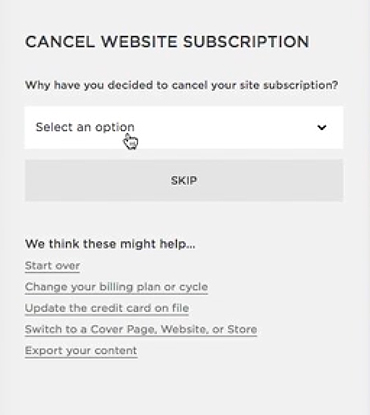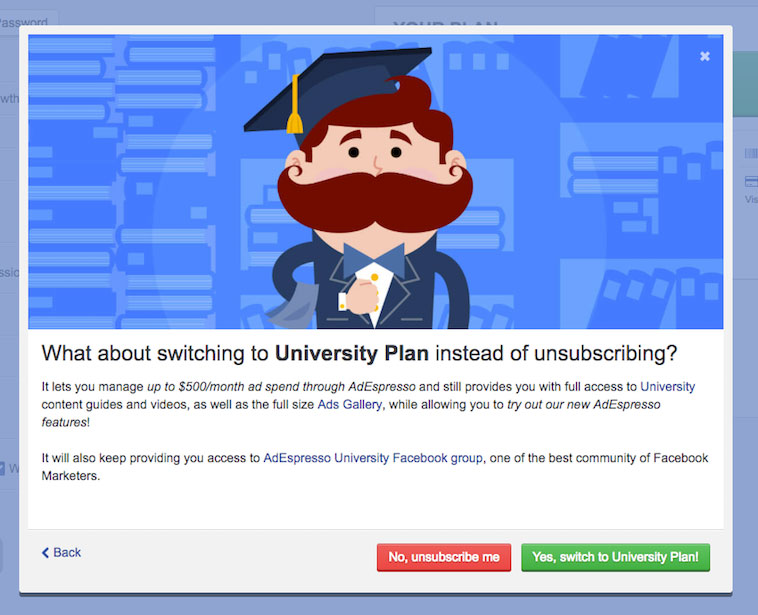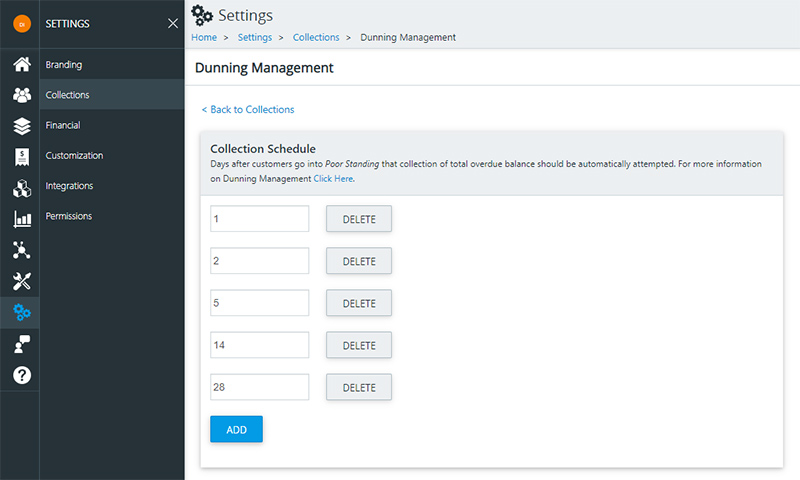Churn rate costs companies worldwide a collective $1.6 trillion every year. This accounts for a 5% loss in revenue for the average business.
And that doesn’t even factor in the loss of potential monthly recurring revenue.
Up to 65% of profit comes from existing customers, meaning each time a customer leaves your business you lose not only the value of the subscription but also the prospect of upsells and expansion.
The strongest SaaS brands in the world make a concerted effort to avoid churn at all costs, with many businesses that deal with enterprise-level customers achieving a rate of 1% or less.
With the right strategies, you can reduce your customer SaaS churn rate and adopt practices that will keep your customers satisfied and sticking around. Customer retention truly is the key to business growth and success.
Hop over here to learn more about how to calculate churn rate for your SaaS business.
1. Offer Your Ready-to-Churn Customer a Good Alternative.
The SaaS juggernaut Squarespace knows a thing or two about retaining customers. Try to unsubscribe from its service and you’ll be brought immediately to a help menu that’s full of alternative options.

Customers are still permitted to end their subscriptions, of course—but only after they consider adjusting their plan or troubleshooting whatever issues they’ve been experiencing.
Why does this work?
Because it’s much more convenient for customers to stick with the provider they already have rather than to research and select a new SaaS option. Why rip and replace when you don’t have to?
Make it easy for your customers to stay and they just might!
2. Remind Them What’s at Stake.
When a customer tries to quit their subscription at digital marketing service provider Proof, they’re instantly reminded of all the features they’ll be missing out on if they leave.
One important thing that gets mentioned? Historic data.
While your competitors may have a similar suite of features, they don’t have the advantage of history and experience that you have with your customer.
Conversely, you may also offer to store data for outgoing customers at the cost of a modest fee. Not only will this keep some MRR trickling in, but it will also keep the lines of communication open for the future.
3. Care For a Downgrade?
While the world of sales has shifted significantly toward a focus on customer experience, price is—and likely always will be—a key brand differentiator. This is particularly true now on the heels of a time when many businesses saw profit declines of nearly 90% during the height of the pandemic.
That’s what makes AdEsspresso’s approach to customer churn reduction is so clever. Go to end your subscription and you’ll be offered to downgrade to its modestly priced University Plan.

The genius part?
There is no University Plan—at least not one that’s listed directly on its pricing page. Only outgoing customers are offered this subscription option, simultaneously enticing them with a discount and an exclusive opportunity.
4. Integrate with Other SaaS Solutions.
Not all churn reduction strategies need to unfold at the last moment.
One of the best ways to keep customers around is to encourage them to integrate your software with the rest of their techstack. This is a common strategy used by everyone from SquareSpace to Google.
For the customer, integration usually makes processes easier and more efficient. For your businesses, it solidifies the relationship, giving your customers one more reason to stick around.
5. Double Down on Onboarding.
More than 60% of consumers consider a company’s onboarding practices before they make a buying decision. Additionally, 55% of people report having returned or discontinued the use of a product because they couldn’t figure out how to use it.
Customers expect a user-friendly experience. If you get off to a shaky start they may very well begin looking for a competitor that can facilitate a smoother ride.
As Paul Philp of customer success platform Amity puts it, “A poor onboarding experience is hard to come back from and is the fastest way to lose a customer. It’s critical to actively think about the customer journey. Define it, map it, document it.”
Fortunately, doing this can be easier than you might first assume. For example, Wootric by InMomement found success by proactively reaching out to its new customers to find out more about their onboarding experience.
If you want to avoid surprises when it comes to churn, how and when you ask for feedback matters, said the company’s General Manager Jessica Pfeifer. Being able to immediately remedy issues can turn potential churn cases into customer success stories.
6. Eliminate Involuntary Customer Churn.
Up to 20% of churn is the product of payment failure. While it’s easy to cycle customers with unpaid and aging receivables out, doing so comes at the cost of what you’re owed and what you could earn from the customer in the future.
An effective dunning management process automates credit card retries and customer communication features. This makes it significantly easier to collect owed revenue without damaging your customer relationships.

Modern recurring billing software solutions come with comprehensive dunning management functionality that simplifies or even automates many processes that help eliminate involuntary revenue churn.
7. Encourage Longer Contracts.
Month-to-month contracts feature a customer churn rate of about 14%—significantly higher than those lasting two years or longer. Naturally part of this discrepancy stems from the fact that happy customers are more likely to opt for longer contracts in the first place.
However, other factors are worth considering too.
- Customers with monthly subscriptions are forced to make a new purchasing decision every few weeks, while those with longer contracts very rarely have to reconsider their relationship with you.
- Longer contracts also allow customers to better acclimate to your product, increasing the odds they’ll begin to derive enough value from it to warrant sticking around.
More annual subscribers often means a lower annual churn rate.
8. Do a Churn Post Mortem.
Sometimes, your churn rate reduction strategy may be less about recovering a specific customer and more about understanding why your customers churn in the first place. Learn how to prevent future churn.
As Bill Gates puts it, “Unhappy customers are your greatest source of learning.”
Mapping out the customer lifetime journey from the moment someone signed on to the second they left can illuminate where your interactions and experience leave room for improvement.
- Maybe your onboarding isn’t all that it could be.
- Maybe your customer communications could use a facelift.
- Or perhaps your product is a little more complex to navigate than you thought.
Less than 5% of dissatisfied customers actually complain, which means most of the time it will be up to you to figure out what went wrong.
Looking for more ways to boost your customer retention rate? Jump over here.
Lower Churn Rates Come From Every Aspect of a Business
It’s fun hearing about the strategies successful businesses use to reel outgoing customers back in. But while the heroic hail-Marys make for good stories, they’re a very small part of what it takes to keep a customer base intact and growing strong.
Businesses retain customers and achieve lower churn rates by making every aspect of their operations customer-centric. As Ilya Azovtsev of Docsify puts it:
“Customer satisfaction is the end result of the whole customer journey. It starts with prospects visiting your website/store for the very first time – and the best thing about this journey is that it never ends. That’s why all your customer communication across all channels should be transparent and aligned from the marketing, sales, and customer support perspectives.”
Focus on keeping your customers happy. Solve their pain points and help them achieve measurable value with your product—they’ll rarely have a reason to leave in the first place.
FAQs about Churn Rate
Q: What is churn rate, and why is it important to address?
Churn rate refers to the rate at which customers stop subscribing to a business’s service or product within a given timeframe. It is critical because it directly influences a company’s revenue and ability to grow.
Q: What amount of profit comes from existing customers in a business?
According to the content, approximately 65% of a business’s profit comes from existing customers. This reflects the value of keeping your existing customers engaged and reducing the churn rate of these customers.
Q: What is an example of a notable SaaS brand that uses a unique approach for retaining customers?
Squarespace, a prominent SaaS brand, employs a unique customer retention approach. When a customer tries to unsubscribe, they are immediately presented with a help menu filled with alternative options, encouraging them to stay.
Q: What beneficial strategies does the digital marketing service provider Proof use to retain their customers?
When a customer tries to terminate their subscription with Proof, they’re promptly reminded of all the benefits they’ll lose if they leave. One compelling advantage mentioned is access to historic data.
Q: How can pricing play a key role in reducing churn rate, as demonstrated by AdEspresso’s approach?
AdEspresso offers a creative approach to customer churn reduction by offering the customers who are about to end their subscription an option to downgrade to a lower-priced University Plan, which isn’t listed on their usual pricing page. This strategy provides customers with a unique opportunity to continue getting a service at a discounted rate, making them rethink their cancellation decision.
Q: Can integrating your software with other tools of your customers help in reducing churn?
Yes, encouraging customers to integrate your software with their existing suite of tools can help reduce churn. It can ease and streamline their processes, fortifying your relationship with the customer, and providing them with another reason to stay.
Q: How does onboarding factor into reducing churn rate?
Robust onboarding practices contribute significantly to churn reduction. A poor onboarding experience can deter new customers from continuing to use a product or service. By understanding and mapping the customer journey, you can more easily identify potential pain points in the onboarding process and refine it accordingly.
Q: What steps can be taken to counteract churn resulting from payment failure?
Implementing an effective dunning management process that automates credit card retries and customer communication features can help mitigate churn resulting from payment failure. It enables collection of owed revenue, without damaging customer relationships.
Q: How can understanding the reasons for customer churn help in charting out effective churn reduction strategies?
Understanding customer churn reasons can provide insights into areas where the products, services, or customer interactions may need improvement. As per Bill Gates, “unhappy customers are your greatest source of learning.” Probing into why customers churn can help identify and rectify issues that lead to customer dissatisfaction or difficulty in using the product or service.
Q: What is the overall emphasis for businesses looking to reduce churn and retain customers?
Businesses aiming to reduce churn and retain customers should focus on making every aspect of their operations customer-centric. This includes providing a transparent and aligned communication across all stages of the customer’s journey with the product, solving their pain points, and assisting them in attaining measurable value from the product.







